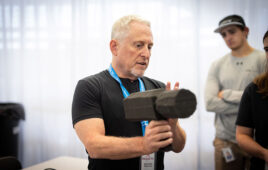Credit: Stanford Univ. |
Anyone who has
ever flown knows the feeling: an otherwise smooth flight gets a little choppy.
If you are lucky, the plane skips a few times like a rock across a pond and
then settles. For the not-so-lucky, the captain has turned on that seatbelt
sign for a reason, but even the worst turbulence usually fades.
In certain
rare situations, however, those vibrations don’t settle and the consequences
turn dire. The twisting, up-and-down movement in the wing builds upon itself,
each wave compounding the next, until the vibration worsens and the wing is
ripped from the plane. In an instant, a simple bit of turbulence becomes a
matter of life and death.
Aeronautical engineers know it as “aeroelastic flutter.” Pilots
call it “buzz.”
Complicated stuff
Aeronautical engineers have puzzled over the phenomenon as long as there have
been planes. They made their planes better. They built them of new materials.
They used supercomputers to predict when it might occur. But, try as they
might, they could not absolutely eliminate aeroelastic flutter.
Professor
Charbel Farhat, chair of the Aeronautics and Astronautics Department at
Stanford’s School
of Engineering, and David
Amsallem, a postdoctoral scholar who worked on his PhD thesis with Farhat, have
been studying and trying to solve aeroelastic flutter for years. Computers
help, but only to a point.
Listening to
Farhat is a bit like flying. He talks quickly with great expression, piloting
the listener through his world, swooping from idea to idea in great arcs like a
stunt plane, always on the edge of control. He is a barnstormer. Amsallem, the
mild-mannered mathematical whiz behind it all, smiles gently, tossing in a
French-accented word of clarification here and there.
“This is
complicated stuff. It takes today’s fastest computer an hour to calculate the
aeronautical effect of even a small change in a single variable,” said
Farhat, his voice rising to deliver the word “today’s” as if to
reinforce that we are not talking about some mid-century mainframe here.
“Imagine a plane in flight and you’ll quickly grasp that there are
hundreds of variables. Now, imagine the rate of change in those variables for
an F-16 at full throttle.”
Each
incremental shift in pitch of the wing, every inch of altitude, every variation
in speed, each milliliter of fuel added or burned sloshing back and forth in
the tank are equally at play—alter one, you alter the entire system. And each
time you alter the system, the supercomputer starts back at go, computing anew—that
is, if you can get time on the supercomputer.
“Now you
begin to understand. This is complicated stuff,” Farhat said. At this
point in the conversation, the professor leaned in. His eyes narrowed and his
tone grew serious. “We can now predict flutter in real time … on an iPhone.”
Someday, he predicted, airplanes will have chips on board that will sense and
counteract flutter in real time.
The work has
caused a sensation in the aeronautics field. When Farhat and Amsallem presented
their paper at the Army Science Conference recently, the crowd of aeronautical
old hands sat stunned as the two did a live demo of their work on an iPad.
Farhat chose the iPad over a smaller device, he said, not for processor
speed—their innovation works fine on an iPhone, he assured—but for pure visual
impact: It looks better on an iPad.
The seat of your pants
Over time, aeronautical engineers have been able to “engineer”
flutter to a point of virtual oblivion—emphasis on virtual. It is now only a
remote risk.
“But,
there are instances when even the smallest of risks is too great a risk,”
Farhat said.
For instance,
when you are a fighter pilot in the saddle of a $60 million F-16, one of the
fastest, most agile fighter planes ever developed. F-16 pilots—and their planes—regularly
endure forces many times that of gravity. A little turbulence can be a big
deal. Each time the wing starts to bounce, no matter how slight the bounce, a
little voice nags in the pilot’s mind, “Is this the one?” If the
vibration fails to fade, the pilot must contemplate the “eject”
button. At this point, it is life or plane. Call it flying by the seat of your
$60 million pants.
How have
Farhat and Amsallem succeeded where others have come up short? The answer
sounds suitably complex: interpolation on manifolds. What it means, in essence,
is approximating unknowns based on known information. The two engineers devised
a system of mathematical approximations that break down complex,
computationally demanding equations into smaller, more manageable parts. In
mathematics, this is known as “reducing.” Reducing allows them to
make some very educated guesses, very quickly.
Starting with
a mostly random, but carefully selected, sample of a few flight conditions—the
variables such as air speed, wing angle, and altitude—they “pre-computed”
a series of reduced-order models using the very supercomputers they aimed to
beat. These models are called “snapshots”—mathematical pictures of
the fluid dynamics at play at each flight point. Farhat and Amsallem stored
these snapshots in a database, which their computer algorithms can later pluck
as needed to make more complex calculations, quite literally, on the fly.
That is the
easy part.
Next, using a
cleverly designed and painstakingly tested methodology, Farhat and Amsallem
segmented data into small groups centered on the pre-calculated points in the
databases. In essence, Farhat and Amsallem drew circles around the things they
knew—those pre-computed flight conditions—and crafted a system to interpolate
the value of any point within each circle.
On a graph,
these “cells,” as they are described, look like living cells with the
known data serving as the nucleus. The rest of the cell is considered of
similar enough aeronautical characteristic to the nucleus as to allow the
engineers to make very educated guesses as to the behavior of the entire cell—allowing
them to determine how the wing will respond at any given moment.
What’s more,
each time they make a new set of calculations, the new numbers are added to the
database, bolstering future results and making their interpolations all the
more accurate. The mathematicians call this “training,” as if they
are teaching the numbers and not the other way around—as if they are telling
the numbers what they can and can’t do.
Thus, the smartphone beat the supercomputer.
A field aflutter
So, what took so long?
“It
sounds simple,” said Amsallem, explaining his work, “but the
mathematics are exceptionally complex and the stakes of being wrong are great.
There’s no room for error.”
Farhat and
Amsallem are able to accurately predict—in real time and where no one had
before—whether a plane will experience flutter. Soon, they hope, all planes
will have active control mechanisms that continually monitor multiple flight
and mechanical data and steer the planes clear of flutter.
While this is
good news for pilots and passengers, the implications of the work run far
beyond the relatively rare, albeit deadly, phenomenon of flutter.
“Our
interpolation method is general enough to work, in principle, on many complex
engineering problems,” said Farhat, hinting at future possibilities.
And this is what has the field aflutter. Everyone from the Air Force to the
Navy to airplane manufacturers to Formula 1 racing teams are lining up—as they
once did for time on the supercomputers—to apply the Stanford aeronautical
algorithm to their problems.





